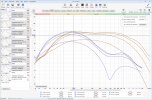I still haven't wrapped my head around all the implications of the fact that "REW's SPL plot is an accurate view of the magnitude response of the system's transfer function", and how that relates to the "volume" of dynamic signals like music. I've seen in REW that if I take my room measurement and also make a "min phase copy", then they have the same SPL. But if I then look at the filtered impulse, things look very different, because the min phase version has a lot more SPL packed into the earliest waves possible. So those impulses have the same magnitude, but do they still sound the same?
So when I compare the 2 speakers above, I wonder the same thing = if the magnitude is the same, does the ratio of early:late energy vs the peak energy moment matter? I had an idea to compare the 2 speakers SPL response with frequency dependant windows. I realised if they weren't weren't time aligned that the results were not comparable (because FDW is pegged to different t=0?), so I edited one response so that the delay was baked in. I chose 148Hz, which was an area where the SPL was the same.

And then I compared the FDW at different cycle lengths, and I again see that the HS5 seems to deliver its energy quicker;

There is a difference here, and the difference is not "SPL". What is this apparent difference?
Edit: As the freq moves away from the aligned point (148Hz), GD differences presumably creep in to the FDW results. But that can't be responsible for the 1dB difference at 148hz.
Or maybe a better a question to ask is, if there is a difference in speed/accuracy beyond group delay caused by the box/filters, where in REW can this be seen?
So when I compare the 2 speakers above, I wonder the same thing = if the magnitude is the same, does the ratio of early:late energy vs the peak energy moment matter? I had an idea to compare the 2 speakers SPL response with frequency dependant windows. I realised if they weren't weren't time aligned that the results were not comparable (because FDW is pegged to different t=0?), so I edited one response so that the delay was baked in. I chose 148Hz, which was an area where the SPL was the same.

And then I compared the FDW at different cycle lengths, and I again see that the HS5 seems to deliver its energy quicker;

There is a difference here, and the difference is not "SPL". What is this apparent difference?
Edit: As the freq moves away from the aligned point (148Hz), GD differences presumably creep in to the FDW results. But that can't be responsible for the 1dB difference at 148hz.
Or maybe a better a question to ask is, if there is a difference in speed/accuracy beyond group delay caused by the box/filters, where in REW can this be seen?
